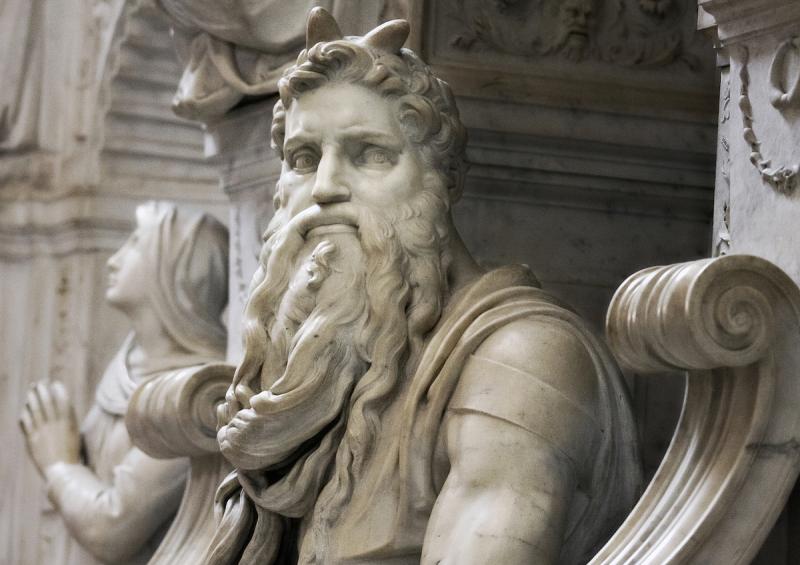Michelangelo, the artist symbol of the Renaissance, is famous mainly for his work on the Sistine Chapel (ceiling and Last Judgement), and for the sculptures of La Pietà and the David.
Michelangelo thought of himself primarily as a sculptor. And if you wish to delve deeper into the life and work of a genius whose art has influenced Western culture greatly, consider the following lesser-known sculptural works, some found in cities or museums you may not expect.
St. Proclus, St. Petronius and an Angel, Basilica of San Domenico, Bologna
The statues of St. Proclus, St. Petronius and an Angel are three - mostly forgotten - small marble sculptures kept inside the Basilica of San Domenico in Bologna, which Michelangelo carved during the time he spent in Bologna as a young artist (1494-1495). It is part of the decoration for the Ark of Saint Dominic, the monumental tomb containing the remains of Saint Dominic, founder of the Dominican order (hence a very prestigious commission even if he only contributed a small part).
Bacchus, Bargello Museum, Florence

Along with the Pietà, Bacchus is the only surviving sculpture of Michelangelo’s first period in Rome. Dating from 1496-97, it was commissioned by a high-ranking cardinal, but rejected once completed. It depicts Bacchus, the Roman god of wine, in a pose and facial expression that suggests he is drunk (in fact, in Italian, it is knows as Bacco ebbro, drunken Bacchus). The cardinal refused the finished sculpture because he deemed it too provocative, a symbol of sexual desire. It was later acquired by banker Jacopo Galli, and then by the Medici and transferred to Florence. It is now on display at the National Museum of Bargello.
Moses, San Pietro in Vincoli, Rome

Right in the heart of Rome’s Monti neighborhood, is a little-known church, San Pietro in Vincoli, not many tourists bother to visit, which is a shame considering that it houses one of Michelangelo’s great masterpieces, Moses.
The colossal marble statue, which measures 2.35 meters, was to be part of the funerary monument that pope Julius II commissioned to Michelangelo in 1505. The tomb was not completed until 1545, 32 years after the death of the pope (!).
The statue depicts a seated Moses, holding the Tablets of the Law under his right arm, in the moments following the delivery of the Commandments on Mount Sinai.
It is said that this is one of Michelangelo’s own favorite sculptures.
Bandini Pietà (or The Deposition), Museo dell’Opera del Duomo (Florence)

Michelangelo tackled the theme of La Pietà throughout his career and this marble sculptural group in particular was conceived by Michelangelo as a monument for his tomb. It is one of his last works, created between 1547 and 1555, and unfinished.
The work first belonged fto the Bandini family in Rome, until it was purchased by the Grand Duke Cosimo III de’ Medici in 1671. First placed in San Lorenzo, it was moved to the Duomo in 1722. It has been in the Opera Museum since 1981.
The Bandini Pietà depicts the dead body of Jesus lying in the arms of his mother Mary, supported by Nicodemus, one of the men who laid down Jesus from the cross, while Magdalene assists. It is believed that Nicodemus, represented as an old man, is a self-portrait of Michelangelo, who was 70 at the time.
Rondanini Pietà, Sforza Castle, Milan

This is the last work by Michelangelo before he died in 1564. He worked on it from 1552 until the very last days of his life. The sculpture revisits the theme of the Virgin Mary mourning over the body of the dead Christ, a theme Michelangelo had previously explored, including in his seminal sculpture, La Pietà (1499), which is housed in St. Peter’s Basilica. Unlike in previous works, here the artist is no longer concerned with the perfection of the body and its beauty, but rather on suffering and death, as he could feel his own death approaching. The Rondanini Pietà can be seen in the Museo Pietà Rondanini inside the Sforza Castle in Milan.











